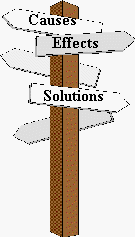 |
Use fertilizers sparingly. Test the soil to see the amount of
fertilizer needed.

|
 |
Don't fertilize before a rain storm.
|
 |
Use organic fertilizers that release nutrients more slowly.
|
 |
Use commercially available compost. Commercial compost and soil
amendments may be available at solid waste or wastewater utilities as
well as garden stores.
|
 |
Substitute biological methods for pesticides and never apply them
near a well or water.
 |
 |
Recycle oil, antifreeze, batteries, fertilizer, pesticides and other
chemicals and materials as much as possible.
|
 |
Control runoff from exposed soil, feedlots and barnyards so that it
doesn't get into drinking water, streams and lakes.
|
 |
Keep barnyards and feedlots clean, and routinely pick up livestock
waste and dispose of it properly.
|
 |
Maintain proper storage of fertilizers, pesticides and other
chemicals and monitor containers for leaks.

|
 |
Maintain farm equipment and monitor for leaks. Use rags to soak up
oils and other chemicals when making repairs. Never let any toxic
materials flow into the ground or water. |


